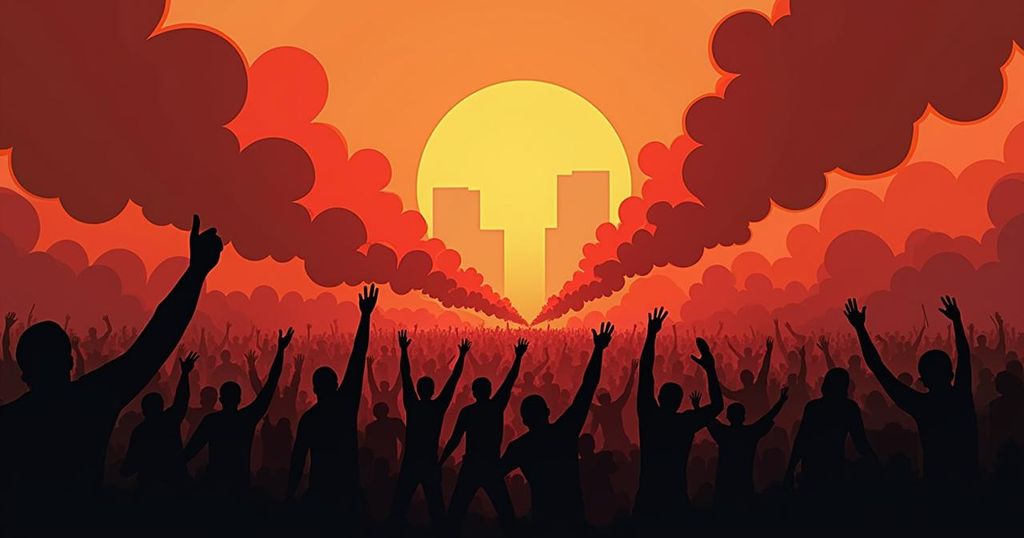On September 27, 2024, large-scale protests erupted in Iran and Yemen in response to Israeli military actions in Lebanon and Gaza. Tens of thousands gathered to express their support for Hezbollah and condemn Israeli actions, while smaller protests took place in Bahrain against Israeli normalization. The protests highlight significant regional tensions and reflect the solidarity among pro-Iran factions amid ongoing conflict.
On September 27, 2024, tens of thousands of demonstrators took to the streets in Iranian cities and the Yemeni capital to voice their outrage against Israeli military actions in Lebanon and Gaza. The protests were spurred by a directive from Iranian officials, who called for gatherings to demonstrate solidarity with Hezbollah and to denounce what was described as the brutal actions of the Israeli regime against Palestinians. Protesters filled Enghelab Square in Tehran following Friday prayers, carrying images of Hezbollah leader Hassan Nasrallah and waving flags representing both Hezbollah and Palestine. Chants filled the air, including declarations such as, “Israel is destroyed. Lebanon is victorious,” as they expressed their discontent about the escalating violence in Lebanon. Additionally, demonstrators burned flags of both the United States and Israel. Demonstrations were also reported in several cities across Iran, including Semnan, Qom, Kashan, Kermanshah, Shiraz, and Bandar Abbas, as state television broadcast footage of the events. In Yemen, the Huthi rebels, who are backed by Iran, orchestrated a massive rally in the capital Sanaa, where supporters rallied with firearms and demonstrative placards. Mortada al-Mutawkil, a Huthi supporter, declared, “We say to our brothers in Lebanon that you will be victorious, God willing,” indicating a belief that the conflict would prolong but ultimately favor Hezbollah. Another participant, Mohammed Mushki, expressed unwavering support for the cause, stating, “No matter how long the war lasts and no matter how big it is, we are on their side, all the Yemeni people, on the side of the Lebanese and Palestinian people until victory, God willing.” In contrast, in Bahrain, a nation allied with Israel, smaller demonstrations were organized, advocating for solidarity with Lebanon and Gaza while calling for a cessation of normalization efforts with Israel. Protesters marched in villages and the capital, voicing their discontent with the ongoing conflict and calling for an end to ties with Israeli authorities. The roots of these protests lie in the recent escalation of violence, beginning with Hamas’s unexpected attack on Israel on October 7, which has led to intensified hostilities, particularly cross-border exchanges with Hezbollah. Israel has conducted extensive raids on Lebanon in retaliation, resulting in a significant death toll and marking some of the most severe violence observed since Lebanon’s civil war. As tensions mount, analysts suggest that Iran remains in a precarious position, supporting Hezbollah while attempting to avoid direct involvement in the conflict. These demonstrations, while serving to affirm the solidarity among pro-Iran factions across the region, reflect the complexities of Middle Eastern geopolitics where local grievances are intricately woven into broader regional narratives of resistance and enmity towards Israel. The ongoing situation necessitates a careful evaluation of both regional dynamics and international political repercussions as communities navigate the devastating realities of prolonged conflict and instability.
The developments surrounding these protests stem from a deep-rooted animosity towards Israel, exacerbated by its military actions in Palestinian territories and Lebanon. The rise of groups such as Hezbollah, which is aligned with Iran, has fostered a coalition strategy against Israel, questioning the legitimacy of its actions. The backdrop of these protests includes the significant escalation of conflict following Hamas’s assault on Israel in early October, which has drawn in various factions across the Middle East, further complicating the regional political landscape. In contrast, nations such as Bahrain, which uphold relations with Israel, showcase the divided opinions within the region, highlighting the complexity of alliances amidst these struggles.
In summary, the widespread protests in Iran and Yemen underscore the strong regional support for Hezbollah and the Palestinian cause amidst escalating violence with Israel. The events reflect a broader narrative of solidarity among Iran-aligned groups in the face of perceived aggression, while also indicating the challenges faced by countries like Iran in navigating these conflicts without direct escalation. The situation continues to evolve, with significant implications for regional stability and future geopolitical dynamics.
Original Source: www.thehindu.com






